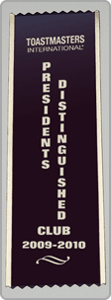 Some people say that the recognition programs focus on the numbers too much, but behind those numbers are members achieving their goals.
Some people say that the recognition programs focus on the numbers too much, but behind those numbers are members achieving their goals.
My favorite educational session is about the Distinguished Club Program (DCP). But I do it a little differently, by showing what those numbers mean. For each DCP goal, I call volunteers out of the audience who are working on that goal and interview them briefly about their objectives and experiences.
For example, on the first goal, I ask for two people in the audience who are working on their CC, and call them up on stage. I ask them what speech they’re on, what they’ve learned so far, and when they expect to complete speech number ten. Ditto for the rest of the education awards.
For new members, I ask for a show of hands for anyone who’s joined in the last few months, call them up (two groups of four), ask them why they joined, talk about their Icebreaker, etc.
Club officer training is similar — ask for a volunteer holding each office, ask them about their role in that office, and get their commitment to twice-a-year training.
Finally, there’s the club officer list and on-time dues, for which I return to the club president, secretary, and treasurer from the previous group.
By now, I have 16 members on the stage, and now it’s time to underline the DCP membership requirement, noting that we need a few more people to round out the club and make a total of 20 (or a net growth of five). There’s usually a few excited audience members who missed out on the earlier interviews who are ready to run up on stage.
I wrap up by summarizing the ten goals, pointing out the members achieving those goals on stage, and presenting the crowd of 20 members on stage as a ten-goal President’s Distinguished “club”, to strong applause.
Really a lot of fun!






